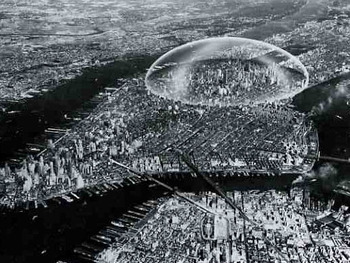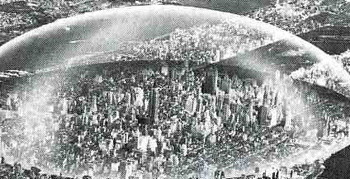JF Ptak Science Books LLC Post #115 (from 2008, extended a little)

Buckminster Fuller had a lot of good ideas but I’m not so sure that this is one of them. I don’t have much doubt that versions of domed cities will exist in the not-dim future, though I do have doubts that they would be constructed to preserve the bones of antiquated ideas. It seems logical to me that the retrofit of untold millions of cubic feet of city life just couldn’t make sense, even if the square footage was in Manhattan.
Domed cities pop up here and there in speculative/science fiction in the 1960's (though there is a far-deep reference to one from the 1860's, though that one is under water), and there are many that are sprinkled like seasoning here and there in more modern formats, as with Stephen King's Under the Dome made into a slappingly-silly tv show of the same name and The Simpson's movie that Borrows Very Heavily from King. There are others to be sure, though I am more interested in miniature domed underground cities or Lego-made Dyson sphere within a Domed Galaxy.
Fuller’s idea (working with Shoji Sadao) is multiple orders of magnitude removed from the original idea of the arcade (like the passage Choiseul, located in the second arrondissement of Paris), envisioning the construction of a dome to encapsulate NYC from the East River to the Hudson along 42nd St, and from 64th to 22nd St: that is two miles in diameter and, plus at least a half-mile high (or about 2.5 Empire State Buildings pile one on top of the other at zenith sector). I’m not so sure how this would be built, or how things would be heated or (especially) cooled, or what the construction material was for the skin of the dome, or how people get in and out, or how you deal with heating and cooling, or how any noxious chemicals are expelled—but Mr. Fuller thought that the savings alone from snow removal from NYC streets would pay for the dome in ten years. (That would maybe work out--the snow-removal analogy--if someone had asked Mr. Fuller exactly how much snow he was talking about...) 
Mr. Fuller also thought that the dome would protect the city (or this part f the city) from radiation fallout. That could be true, assuming that of all the hundreds of nuclear warheads that the Soviets would’ve launched against NYC alone none of them would’ve found their target, except perhaps for the Ridgways or Staten Island, where the shock wave or winds produced by ensuing firestorms would not have disturbed the dome. Of course if a warhead actually came close—or actually hit—the dome, the protection from radiation would be moot.
Source: Buckminster Fuller in Think magazine, vol 34, Jan/Feb 1968. AND of course the lovely work by Alison and Sky Michele Stone, Unbuilt America, McGraw Hill, 1976, pg. 99.


Comments